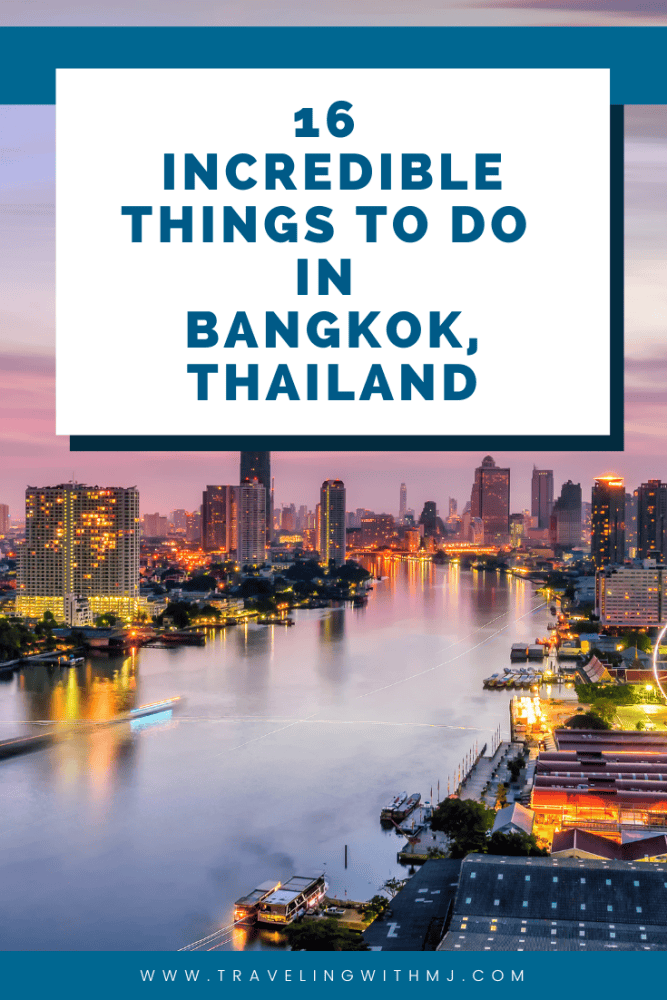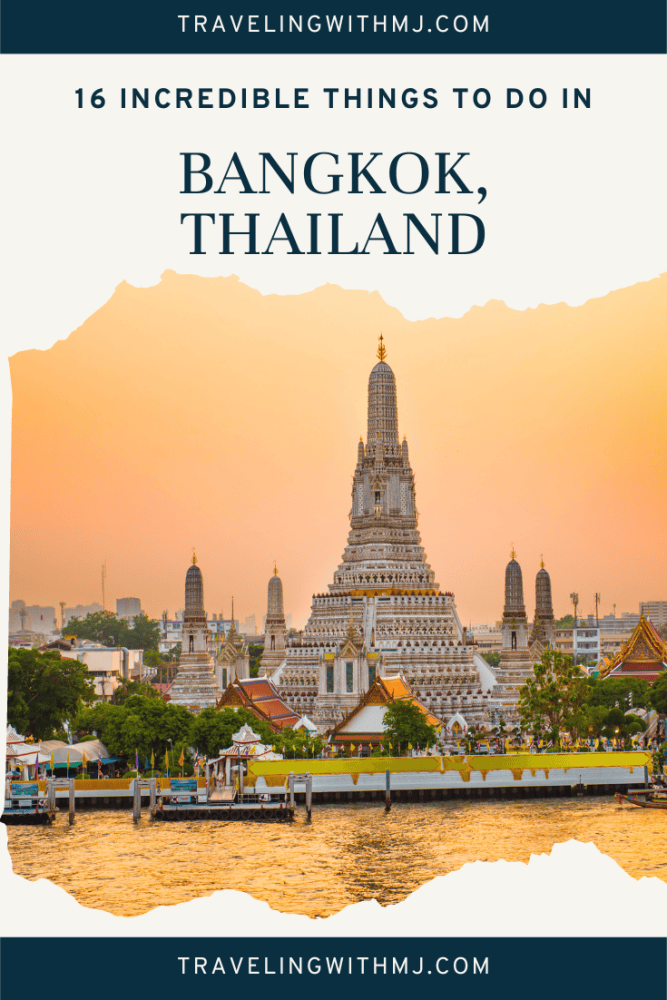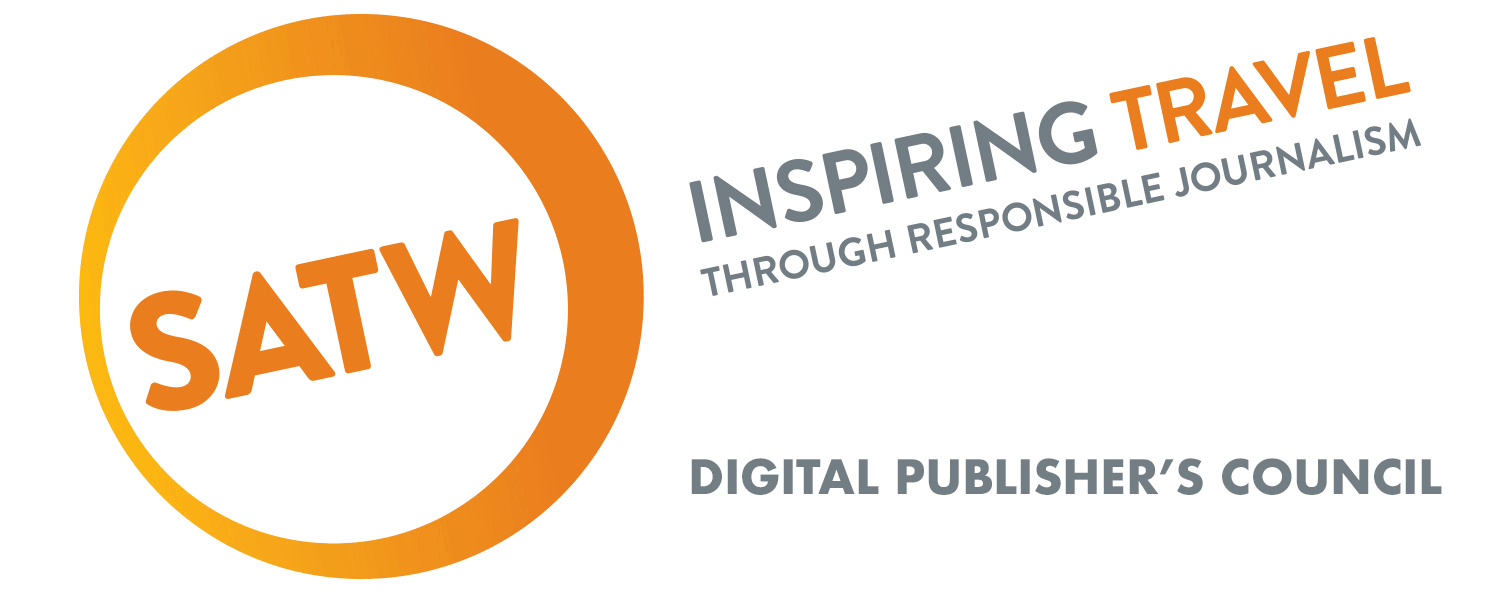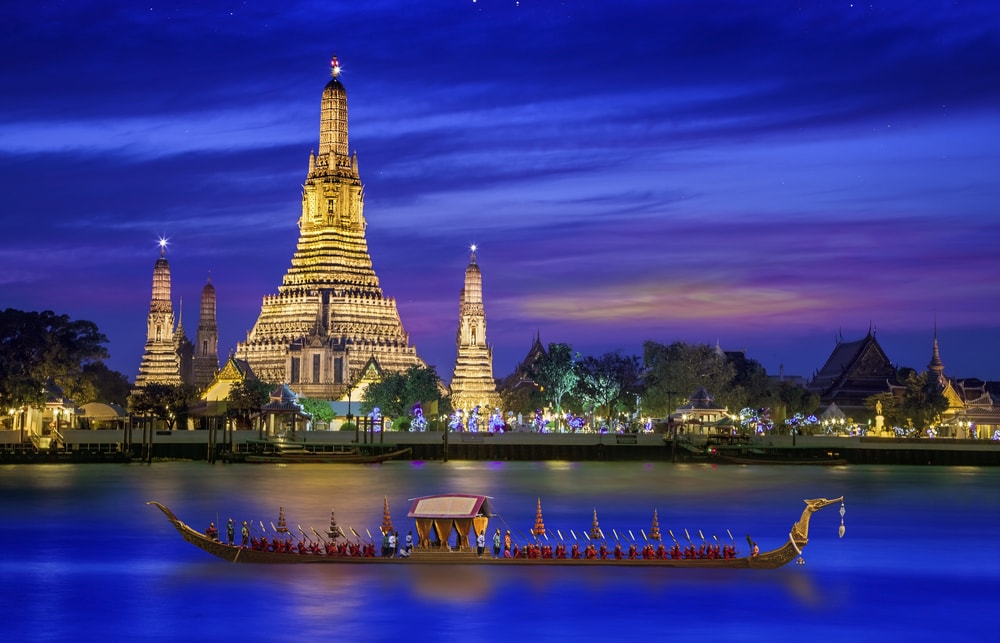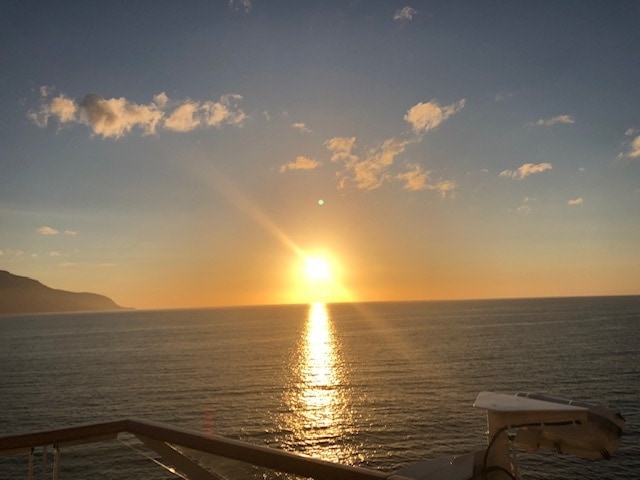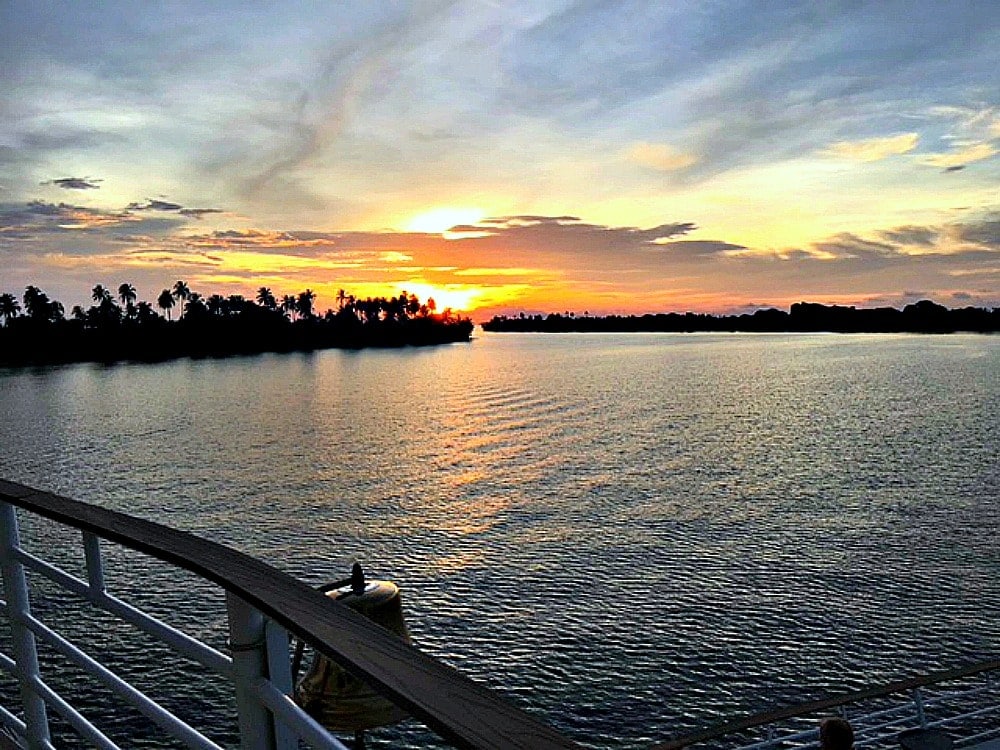Bangkok, a bustling metropolis, is not just busy, it’s also friendly and a paradise for food enthusiasts. And don’t even get me started on the nightlife! It’s a city that truly never sleeps. But don’t worry, Bangkok is typically a safe and welcoming place for travelers.
Known as the “City of Angels that never sleeps,” Bangkok is a place of historic landmarks, delicious cuisine, and limitless entertainment options. Getting around is easy with its efficient Skytrain, underground, tuk-tuks, taxis, and even the occasional trundling ancient bus. Whatever your taste or lifestyle, you can find it in Bangkok.
If you’re planning a visit, I highly recommend coming during the “cool season” from late November to mid-January when the temperatures are a bit more bearable, around 90 Fahrenheit (36 Celsius) – especially if this is your first time visiting. But the best time to visit Bangkok is when it fits into your schedule,
So grab a notebook and start making notes about Bangkok attractions, things to do around the city, and start planning an incredible experience in one of the most popular destinations in Asia.
Here are 16 ideas to get you started in this incredible city.
- Visit the Grand Palace and Wat Phra Kaew
- Try Out Baan Tha Tien Cafe
- Explore Wat Arun
- Wander Through Chinatown
- Shop at Chatuchak Weekend Market
- Indulge in Street Food
- Check Out The Floating Market
- Food With a View at Prakai Cafe
- The Nightlife
- Visit the Shopping Malls
- Watch a Muay Thai Fight
- Visit Museum of Siam
- Visit Jim Thompson’s House
- Experience Thai Massage
- Take a Tuk-tuk Ride
- Explore Dream World Bangkok
- Where to Stay in Bangkok
- Know Before You Go to Bangkok
- For Pinterest
Visit the Grand Palace and Wat Phra Kaew
Located in the busy streets of Bangkok is a place of history and grandeur – the iconic Grand Palace and Wat Phra Kaew. While Bangkok has many interesting sights, this is one of the must-see for most visitors.
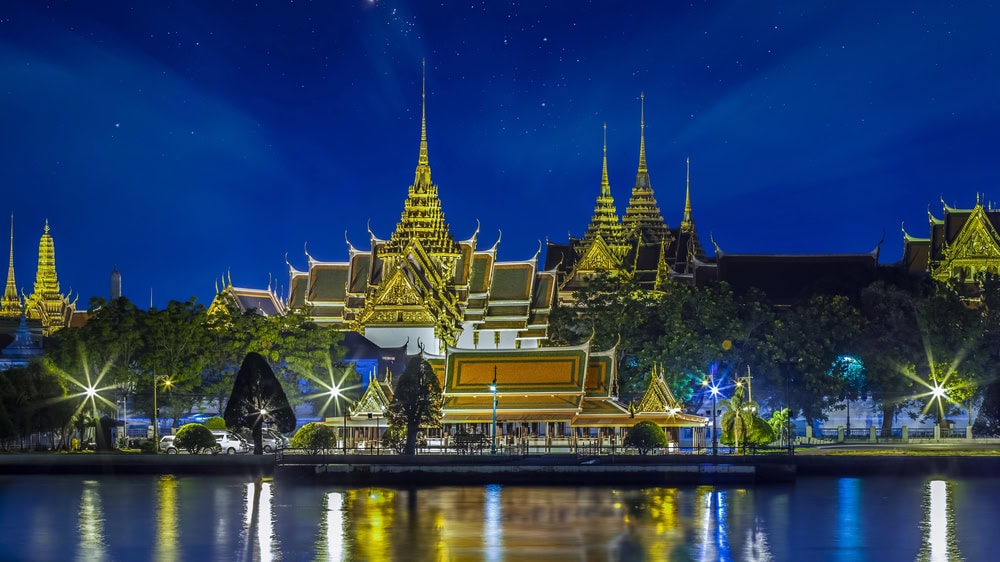
As you enter the Grand Palace and Wat Phra Kaew, you will be overwhelmed with amazement. I remember feeling that same excitement as I began on my tour around these iconic landmarks. The Grand Palace is stunning, with detailed architecture and elegant design that combines Thai, European, and Asian influences.
And then there’s Wat Phra Kaew, home to the famous Emerald Buddha. Standing before this ancient statue, sculpted from a single block of jade, felt surreal. The temple’s interiors are adorned with gold-plated decorations and mosaic-covered stupas. During my visit, I also learned that the King of Thailand changes the costume of the Emerald Buddha in a seasonal ceremony.
Despite the beauty and grandeur of these sites, make sure to be cautious of the possible scams waiting outside the palace gates. It’s important to be cautious and only pay the admission charge when you actually enter the palace grounds.
Keep in mind photography is normally not allowed within the temple, and the temples can be quite crowded.
Try Out Baan Tha Tien Cafe
Located near the Grand Palace and Wat Pho, I discovered this gem while visiting Bangkok’s historic Tha Tien neighborhood. I must admit, my expectations were low, given its touristy location, but hunger led me to give it a try – and I’m so glad I did!
Despite catering mostly to tourists and groups, the food here exceeded my expectations. The Pad Thai was delicious, bursting with flavor and authenticity. And don’t miss the Tom Yum soup, which had a spicy kick that warmed me from the inside out.
They also have long communal tables perfect for groups. After a busy morning of sightseeing, it was a relief to sit down, enjoy a cold drink, and recharge. The staff was friendly, the food was fantastic, and the overall experience was unforgettable. So, if you find yourself near the Grand Palace or Wat Pho area, don’t miss the chance to visit Baan Tha Tien Cafe.
Explore Wat Arun
Explore the stunning Wat Arun, also known as the Temple of Dawn, on Bangkok’s Chao Phraya River. Wat Arun’s towering spires, covered with mosaic tiles and seashells, are high on the list of places for tourists to visit. The temple’s design and sculptures are impressive when viewed from the water. The Temple is worth viewing from land as well as from the river.
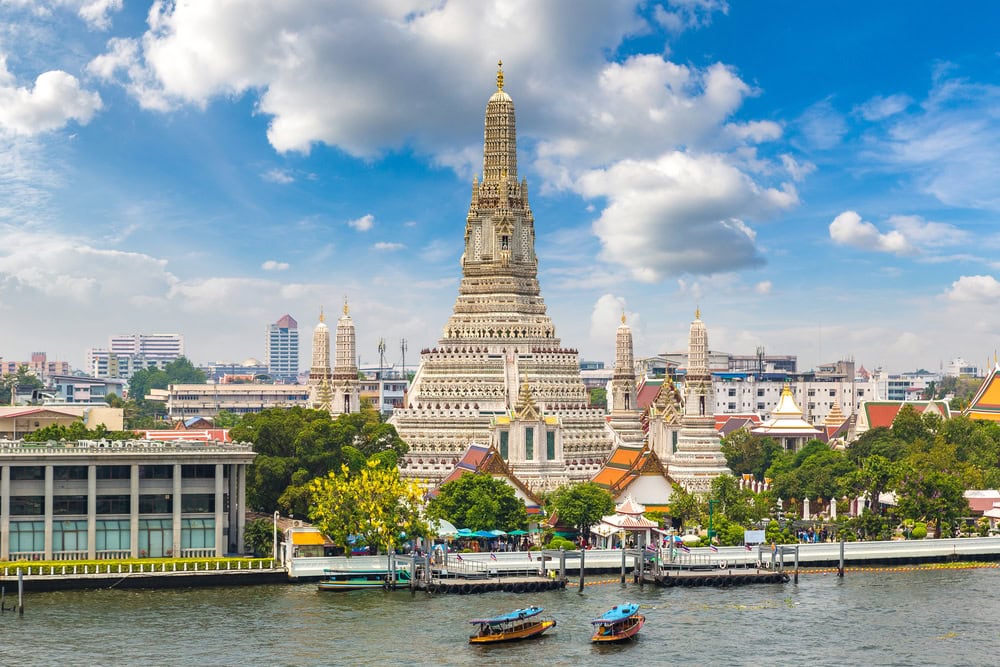
There’s a peaceful ambiance with lovely views from the top of the central prang. Wat Arun’s central spire is beautifully constructed and covered with countless pieces of Chinese porcelain and seashells. It’s impressive to think that these ceramics were once used as ballast on Chinese ships before being repurposed into the temple’s design.
Exploring the temple grounds further, you’ll find myriad sculptures and sacred spaces that provide insight into Thai Buddhism and culture. You can even get a blessing from a monk.
Siamese cats roam about, allowed a places of honor on the site as a breed native to Thailand dating back to when the country was called Siam. They wander freely, curiously watching visitors, and only occasionally allowing pts. My own Siamese cat takes the same approach in his “temple” here at home.
Wander Through Chinatown
Next, explore the lively streets of Bangkok’s Chinatown. Chinatown offers a variety of authentic Chinese food from flavorful dim sum to crispy duck. And the best part? These food stalls have very affordable prices.
But Chinatown isn’t just about food – it’s also a shopper’s paradise. As one of the largest Chinatowns in the world, it offers a variety of shopping options, from gold shops to markets like Sampeng Market and Talat Noi Market. Yaowarat Road, the main artery of Chinatown, is a great place to start. The street vibrant with shops selling everything from fresh seafood to traditional Chinese medicine. Don’t pass up some street food as vendors prepared the food right in front of you.
Also, getting to Chinatown is easy, you hop on the metro or walk from nearby landmarks like Wat Traimit Temple.
Shop at Chatuchak Weekend Market
Wander around the maze of almost 8,000 stalls at Chatuchak Weekend Market, offering everything from clothing and jewelry to handicrafts and home décor. You’ll find Thai handicrafts and traditional goods on display, but keep an eye out for cheap knock-offs.
Navigate the crowds and dealing with the heat were all part of the experience, although coming early or late in the day helped to beat the rush – and the weather.. Bargaining here is a must. Although I am very uncomfortable with haggling, it is expected and the best way to find a great deal.
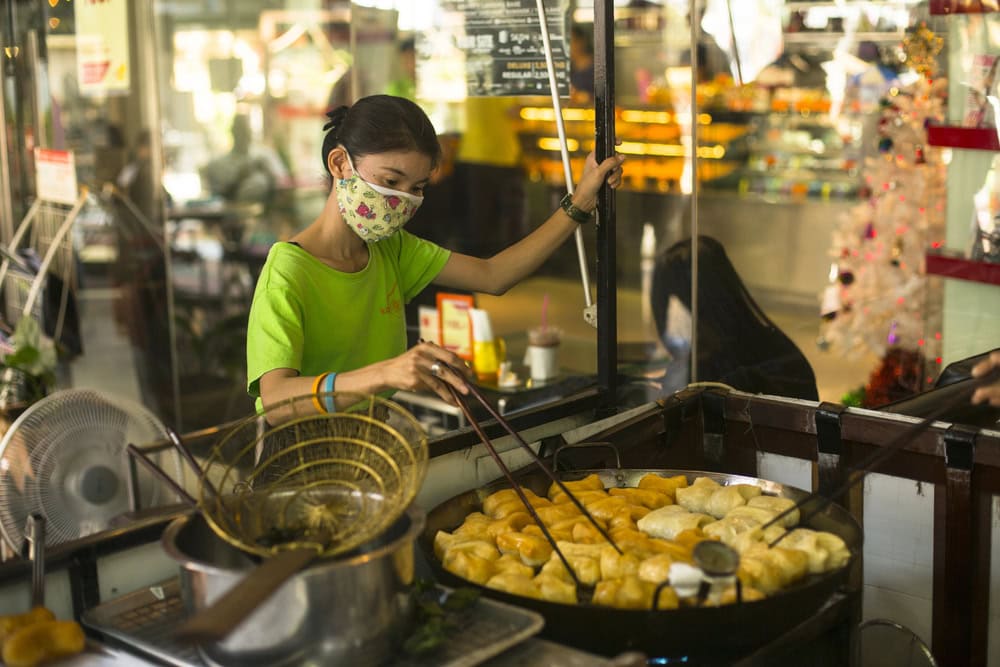
Getting to Chatuchak Weekend Market: Take the Metro to the Mo Chit BTS station and follow the crowd to the front gates. It’s worth the journey for the huge selection and cheap prices. But it’s not just for shopping. It’s a local experience. Lots of locals.
Indulge in Street Food
Thai street food is part of the country’s lively culinary scene. It’s delicious and inexpensive, too.
There are a lot of excellent and affordable dishes to try:
- Pad Thai, a stir-fried noodle dish with flavors of shrimp, tofu, or chicken, all perfectly seasoned with tamarind sauce, fish sauce, and chili flakes. It’s not like you’re used to at your neighborhood Thai restaurant at home.
- Tom Yum Goong, a spicy and sour soup packed with shrimp, lemongrass, galangal, kaffir lime leaves, and chilies. Whenever I’m feeling a little under the weather, this is one of my favorite things that eases a sore throat or helps with sinus congestion.
- Gaeng Keow Wan Gai, or Thai Green Curry, a creamy and aromatic curry, made with green curry paste, coconut milk, chicken, eggplant, and Thai basil. I usually pass on this at home, but in Thailand, it’s not to be missed.
- Som Tum, a refreshing and tangy green papaya salad. Made with shredded papaya, cherry tomatoes, green beans, peanuts, and chilies, it’s the perfect balance of flavors and textures.
- Moo Ping, grilled pork skewers.
- Gai Tod, crispy fried chicken.
- Khao Niew Mamuang, sticky rice with mango. I can never get enough of this!
- Khanom Krokm coconut pancakes.
If you are feeling a little intimidated by the food stalls and street vendors, consider a food tour. Or a Thai cooking class. While Bangkok has its share of Michelin-star restaurants, some of the best food can be found on the street.
Check Out The Floating Market
First up is Damnoen Saduak Floating Market, which is around 50 miles from downtown Bangkok. You can explore the market waterways in a long-tail boat, stopping to make purchase from local vendors selling fresh fruits and vegetables, souvenirs, and other Thai foods. Try the sizzling hot noodles cooked right on the boat.
A it further away is the Amphawa Floating Market, which is around 55 miles from downtown Bangkok. This charming market is only open weekends, Friday to Sunday, and traditional Thai wooden houses line the canals. This is a much smaller market than Damnoen Saduak, but feels more authentic.
For something closer, about seven and half miles away from downtown Bangkok, is the Taling Chan Floating Market. This is, again, a much smaller market with fewer patrons. The market has been featured in various action adventure movies, including the classic James Bond film The Man with the Golden Gun. This is a great spot for fresh seafood.
A structured tour is an easy way to see the night markets, combining transportation with shopping and sightseeing.
Food With a View at Prakai Cafe
Prakai Cafe has a spacious and inviting atmosphere, but is probably best appreciated for its beautiful waterfront view. The modern design and big mirrors created a stylish atmosphere, while the outdoor section provided enough sitting and photo spots. There’s even an artificial waterfall.
Now, let’s talk about the food! While the restaurant’s menu includes savory delights like spicy rice porridge with stewed beef and beef with basil rice, there are also vegetarian options. For breakfast or brunch, try avocado toast or handmade pastries like croissants and muffins. If you’re in the mood for something savory, their grilled sandwiches are delicious and served with a side of crispy fries or salad.
But let’s not forget about dessert! The mango roti is the highlight for me. A crispy and flaky roti topped with juicy mango and sweetened condensed milk, makes a perfect ending to a perfect meal. It’s worth a return trip.
The Nightlife
As the sun sets, Bangkok’s streets become full of night time activity. Start the evening at one of the lively night markets, the most famous of which is Khao San Road.
While I prefer a fun night market, a delicious dinner, and relaxing views, there’s no denying the attraction of the club and partying scene in Bangkok. I had to draw on the expertise of some friends to get the scoop here.
A consistent club mentioned for the young set is The Club at Koi. It features top-notch local and international DJs, spectacular panoramic views, and a lively fun atmosphere. It’s a perfect place to party till early hours of the morning. Other clubs frequently mentioned: Levels Club & Lounge, Route 66, and Club Onyx. Note that some of the clubs have a strict dress code.
While enjoying Bangkok’s nightlife, it’s important to prioritize your safety, Drink responsibly, look out for one another, and always be mindful of your surroundings.
Visit the Shopping Malls
Start your mall adventure at Fashion Island, a large retail center located in eastern Bangkok. Currently ranked as the twenty-sixth largest mall in the world, it offers a wide range of shopping options to suit every budget and style. Clothing, jewelry, electronics, and other items are available for sale, ranging from high-end brands to affordable fashion deals.
Next, visit ICONSIAM, a shopping spot located near the Chao Phraya River. As one of Southeast Asia’s largest malls, ICONSIAM is a shopper’s paradise, offering a wide selection of luxury designer stores, local shops, and worldwide brands. And when you need a break from shopping, there are plenty of dining and entertainment options available.
Or, if you want to skip the larger malls, ask for recommendations for small, local businesses. On one of my first trips to Thailand, I wanted to find a tailor and have custom clothes made in Bangkok. I have introduced friends and family to the business and most of us still do business with them today.
Whether you’re a shopping fashionista, forgot to pack something for your trip, or are looking for fun souvenirs, Bangkok shopping has you covered.
Watch a Muay Thai Fight
Watching a Muay Thai fight in Bangkok is a glimpse into Thai culture and martial arts heritage. Muay Thai is a type of martial art and combat sport that uses punches, kicks, elbows, and knee strikes. Fighters use their whole body to attack and defend, and the matches involve intense physical conditioning and strategy in a show of power, agility, and technique.
Some of the top venues in Bangkok to see a Muay Thai fight are: Lumpinee Stadium, Rajadamnern Stadium, Channel 7 Stadium, and MAX Muay Thai Stadium. The event usually has several matches on the program. Arrive early to get a good seat as well as to take in the atmosphere before the fights begin.
Visit Museum of Siam
The Museum of Siam, established in 2007 in the former Ministry of Commerce building, is dedicated to the history and culture of Thailand. It offers interactive exhibits and displays that explore Thai society, from its ancient roots to modern times. The museum uses multimedia presentations, hands-on activities, and engaging narratives to provide visitors with a comprehensive understanding of Thai identity, traditions, and development.
Visit Jim Thompson’s House
Visiting Jim Thompson’s House in Bangkok offers an intriguing look into the life and legacy of the American entrepreneur who helped revive Thailand’s silk industry during the 1950-60s.
Thompson, a former intelligence officer, settled in Bangkok after World War II. He became fascinated with Thai culture and craftsmanship. Thompson played a pivotal role in promoting Thai silk to international markets, helping to elevate it from a local craft to a global luxury product.
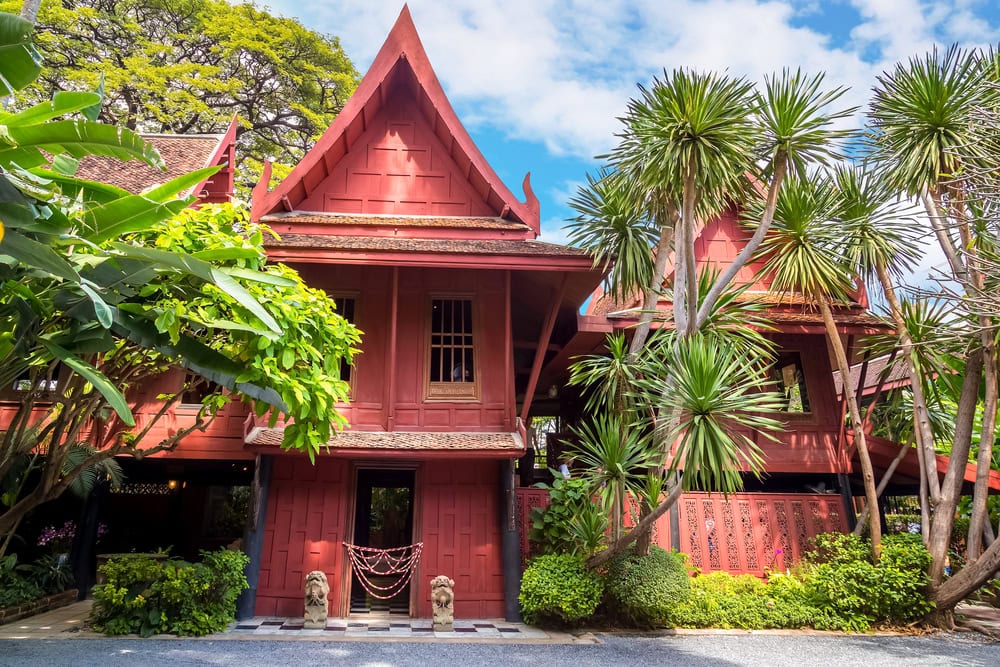
Apart from his contributions to the silk industry, Thompson is also known for his architectural legacy. He built a traditional Thai-style house in Bangkok, which is now known as the Jim Thompson House Museum. This museum showcases his collection of Asian art and antiques and offers insight into his life and contributions to Thai culture. Thompson’s mysterious disappearance in 1967 while on vacation in Malaysia has added to his legendary status in Thailand.
While there is an elevator in some sections, Jim Thompson House is really not wheelchair accessible.
Experience Thai Massage
A traditional Thai massage in Bangkok is the perfect way to engage yourself in the city’s rich culture of relaxation. Thai massage, or “Nuad Thai,” uses acupressure, stretching, and yoga-like positions to improve both physical and mental health. There are plenty of massage parlors and spas across Bangkok, offering authentic Thai massage experiences to suit every budget.
Upon entering a massage parlor, you are usually asked to change into comfortable clothes provided by the facility. During the massage, licensed massage therapists will use their hands, elbows, knees, and feet to apply pressure at particular points along your body’s energy lines, known as “sen.” This rhythmic pressure, along with stretching and other manipulations, helps ease tension, increase flexibility, and promote relaxation.
I enjoy a good Thai massage, but have never considered it relaxing. I feel relaxed afterwards, but it’s not like I’m falling asleep while it’s going on.
Take a Tuk-tuk Ride
A tuk-tuk is a three-wheeled motorized rickshaw that’s practically an icon in Bangkok and many other Southeast Asian cities.
It’s essentially a small, open-air taxi or auto-rickshaw with a motorcycle or scooter engine. The design of a tuk-tuk typically consists of a cabin with seating for passengers, a driver’s seat, and a canopy or roof for shade. The vehicle is powered by a gasoline engine, which drives the rear wheels, and it’s steered using handlebars like a motorcycle.
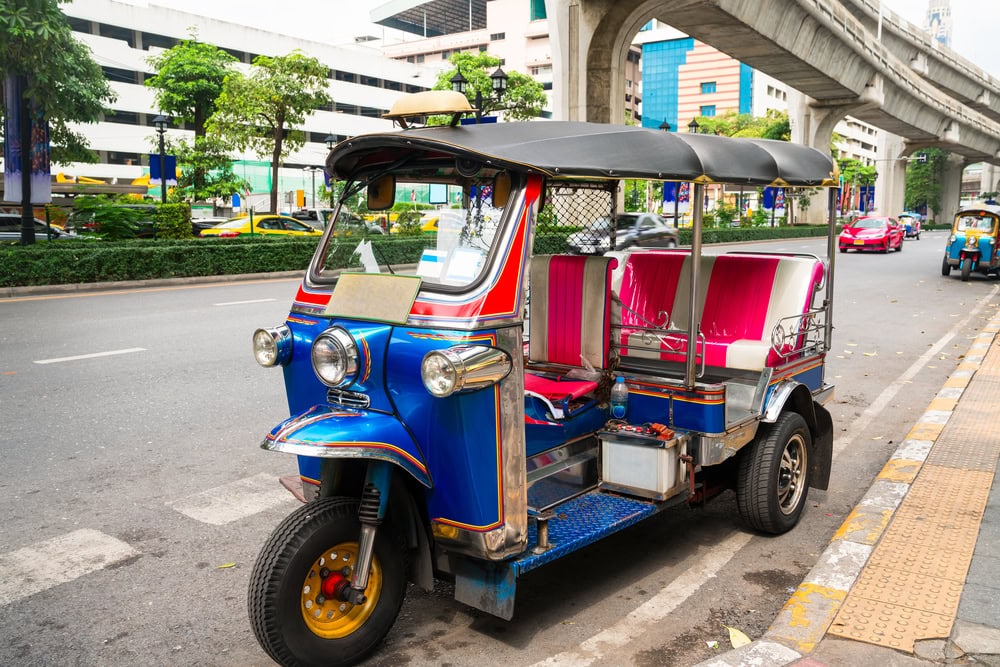
Tuk-tuks are popular for short-distance travel within cities and towns, offering a convenient and relatively inexpensive way to get around. They can navigate narrow streets and congested traffic more easily than larger vehicles, making them well-suited for urban environments. Hailing a tuk-tuk is easy – just raise your hand and wave them down when you see an empty one passing by.
The cost of a tuk tuk ride will vary based on factors like distance and time of day, but it also depends on your negotiation skills. Negotiate the fare before hopping in. Bargaining is part of the fun, so keep it friendly and polite. And if the initial offer seems a bit high, don’t worry – there’s always another tuk-tuk around the corner.
Tip: Carry small bills and coins in local currency to make negotiating easy.
Explore Dream World Bangkok
Dream World Bangkok is a popular amusement park located in Thanyaburi, a district in the northern part of Bangkok, Thailand. It’s one of the largest theme parks in the country and offers a variety of attractions and entertainment for visitors of all ages.
The park has four areas: Fantasy Land, Adventure Land, Dream Gardens, and Dream World Plaza. Within in area, there are rides, water park, gardens, shopping, dining, and other entertainment options. Don’t expect to see Mickey Mouse here, but if you’re a Disney World enthusiast, some rides and settings might give you a familiar vibe.
Standard theme part recommendations apply. Arrive early, create a plan to avoid long lines during peak ride time, keep hydrated, pack your patience.
Where to Stay in Bangkok
Lodging options in Bangkok cover the spectrum, from luxury hotels to hostels, with corresponding pricing. Airbnb and other apartment rentals are also an option. I tend to prefer a hotel in the city, close to attractions and transportation, that skews to the luxury end of things. Your preference may go in another direction, especially if traveling with a group or larger family.
You can start looking for information on where to stay and rates here.
Know Before You Go to Bangkok
Airport: The main international airport serving Bangkok is Suvarnabhumi Airport (BKK). Suvarnabhumi Airport is one of the busiest airports in Southeast Asia and serves as a major hub for both domestic and international flights. While airline schedules change regularly, there are generally direct flights to Bangkok available from Los Angeles (LAX), San Francisco (SFO), New York (JFK), and Dallas (DFW).
Currency: The currency in Thailand is the baht (THB). When I’ve traveled to Thailand, I use an ATM machine at the airport or a local bank to get bahts.
Electricity: Thailand uses Type A, B, and C plug-ins. Type A is the standard U.S. version with two flat parallel prongs, and Type B is the same with a grounding prong added. You will also find Type C plug-ins, the European-style with two round pins, at many hotels. I usually toss in an adapter – just in case.
Time Zone: Bangkok is in the Indochina Time Zone, UTC+7. When it is 5 pm in Seattle, it is 7 am in Bangkok the following day (add 14 hours). Thailand does not adjust clocks for daylight savings time.
Safety: Bangkok is generally a safe city for travelers, but like any large urban area, general safety precautions make good sense. Stay aware of your surroundings, keep your valuables secure, and respect local customs and laws. Pretty commonsense precautions for travel in any destination.
Religion: Thailand is a predominantly Buddhist country, and Buddhism plays a significant role in Thai culture and society. Religious customs and rituals are an integral part of daily life in Thailand, with temples serving as centers of community activity and spiritual practice.
Language: The primary language is Thai. Since Bangkok is the Thai capital as well as an international hub, English is spoken is tourist areas (hotels, restaurants, transportation hubs). Many signs are posted in both Thai and English in the business areas of the city.
Getting Around: The BTS Skytrain (Bangkok Mass Transit System) and the MRT (Mass Rapid Transit) have extensive coverage and are easy to navigate. BTS is elevated, and MRT is underground, and the two complement one another to cover various parts of the city. Taxis, buses, motorcycle taxis, and tuk-tuks are also available, but given the horrendous traffic in the city, keep to mass transit when you can. Boats and ferries operate on the Chao Phraya River and its canals, providing both a means of transportation and a scenic tourist experience.
Medical Information: Bangkok has a well-developed media system with modern hospitals and highly trained medical professionals. No surprise there; Bangkok is a popular destination for medical tourism. We always recommend travel and health insurance with coverage in international destinations.
Visitor Requirements: No tourist visa is required for U.S. citizens for stays of up to 30 days when entering the country by air, and 15 days when entering by land. Citizens from other countries may require one. Check with your local government entities for further information. Your passport must be valid for at least three months before your planned departure date. Again, check with the state department for any changes. Immigration officials may ask for proof of onward travel, such as a return ticket or itinerary, to ensure that you intend to leave Thailand within the allowed period.
Climate: Bangkok has a tropical climate characterized by hot and humid weather year-round, with distinct wet and dry seasons. The hot season is March to May, the wet season is June to October, and the cool season is November to February. Note that even in the cool season, daytime temperatures run in the high 70s to low 80s.
Emergency Numbers: Tourist Police – 1155 (with English speaking operators available). Police – 191. Medical Emergency – 1669, and ambulance 1554 or 1646, Fire – 199. General Emergency Hotline – 112.
Holidays: During public holidays and special observances, some businesses and public offices may be closed or operate on reduced hours. Some general observances to be aware of, or perhaps to be used in planning your trip:
- Songkran Festival – This Thai New Year festival is celebrated in mid-April. The celebration is well known for its water fights and water-related festivities, symbolizing the washing away of the past year’s misfortunes and welcoming the new year with fresh beginnings.
- Thai National Day (King’s Birthday) – December 5th is celebrated as Thai National Day and marks the birthday of the late King Bhumibol Adulyadej (King Rama IX), who was highly revered by the Thai people. This day is observed with various ceremonies and displays of respect for the monarchy.
- Loi Krathong – Loi Krathong is a beautiful festival celebrated on the full moon night of the twelfth lunar month (usually in November). During this festival, people release decorative floating lanterns (krathongs) onto rivers and waterways to pay homage to the water goddess and symbolize letting go of negativity and making wishes for the future. I was fortunate to visit one year during the celebration and releasing my krathong (and cares) was a moving experience.
- Chinese New Year – Also known as Lunar New Year or Spring Festival, it is celebrated by Bangkok’s large Chinese community. Festivities include dragon and lion dances, traditional ceremonies, and vibrant street decorations in Chinatown and other Chinese-influenced areas of the city.
- Visakha Bucha Day – This is one of the most important Buddhist holidays and commemorates he birth, enlightenment, and death of Buddha. It falls on the full moon day of the sixth lunar month (usually in May). Buddhists visit temples to make merit, listen to sermons, and participate in candlelit processions.
- Royal Ploughing Ceremony – The Ceremony, usually held in May, marks the traditional beginning of the rice-growing season in Thailand. It’s a ceremonial event presided over by members of the Thai royal family and involves the symbolic planting of rice seeds by sacred oxen.
For Pinterest
Save to your favorite Pinterest boards and start planning for your trip to Bangkok, Thailand
